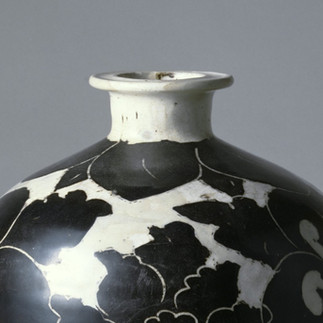宋代筆記 vol.139 五島美術館:白釉黒花牡丹文梅瓶磁州窯,重要美術品 - Gotoh Museum, Cizhou Black and White Sgraffiato Meiping Vase, Important Art Object
- SACA

- Jul 9
- 3 min read

本器為磁州窯系典型之白地黑花陶器,以“白化妝”技法製成,即於素胎表面薄施白色泥漿,再以鐵質顏料描繪花卉紋樣,畫面以線刻法刻出兩朵向上與向下盛開的大牡丹花,並以纏枝唐草將之連繫,隨後以鋒利工具將花紋地子部分的鐵繪掻去,使主體紋樣浮現。此種剔花技法為磁州窯的重要裝飾特色。磁州窯為宋代民窯之代表,分布於今河北省邯鄲市郊一帶。
此類白地黑剔花梅瓶在磁州窯中也有窯口的細分,以當陽峪窯質量為上乘。此外,黑色花卉的藝術性也應列入品級考量範圍。五島美術館這件是同類型中藝術性最高之一,由兩朵巨大的牡丹組成,一朵朝上,一朵朝下,是同類中的絕品。
Among Cizhou-type meiping vases with black-sgraffito decoration on a white slip ground, distinctions can be made based on specific kiln sites. Among them, works from the Dangyangyu kiln are regarded as being of the highest quality. In addition to technical execution, the artistic merit of the floral motifs—particularly the expressiveness and composition of the black-painted decoration—should also be considered in evaluating a piece’s rank.
The example in the Gotoh Museum represents one of the finest known specimens of this type. Its decoration features two monumental peony blossoms—one facing upward and the other downward—executed with exceptional boldness and elegance, making it a masterpiece among surviving examples.

白釉黑花牡丹文梅瓶(磁州窯)
陶器 / 一口
宋時代・12世紀
高33.0公分,口徑7.2公分,胴徑20.7公分,底徑8.8–8.7公分
藏於五島美術館
本器形制為“梅瓶”,其特徵為口小、肩寬、腹部收束之形狀。梅瓶之名始見於元代,蓋源於常用以貯放梅酒或插梅花。該式樣自宋代起廣泛於各地窯場燒製,通常配有蓋,惟本器未附原蓋。

Cizhou Black and White Sgraffiato Meiping Vase, Important Art Object
Stoneware / One piece
Song dynasty, 12th century
Height: 33.0 cm; Mouth diameter: 7.2 cm; Body diameter: 20.7 cm; Base diameter: 8.8–8.7 cm
Gotoh Museum collection
This meiping vase is a representative example of black-painted Cizhou ware, produced using the white slip technique: a thin layer of white clay slip was applied over the body, upon which designs were painted in an iron-rich pigment. The decoration features two large peony blossoms—one facing upward, one downward—connected by scrolling foliage, executed with line carving. After outlining, the background pigment around the motifs was scraped away with a sharp blade, a decorative method known as sgraffito, typical of Cizhou production.
Cizhou kilns were among the most prominent folk kilns of the Song dynasty, primarily located around the present-day outskirts of Handan city in Hebei Province.
The vessel is of the meiping form, characterized by a narrow mouth, broad shoulders, and a constricted waist. Though the term meiping ("plum vase") is a later appellation, it likely derives from its association with storing plum wine or displaying plum blossoms. This form began to be widely produced from the Song period onward across various kilns. While such vases typically came with a fitted lid, the present example lacks one.

重要美術品
白釉黒花牡丹文梅瓶磁州窯
はくゆうこっかぼたんもんめいぴんじしゅうよう
陶器/一口
宋時代•12世紀
高33.0cm 口径7.2cm 胴径20.7cm 底径8.8-8.7cm
五島美術館藏
白化粧という、白土や白泥などを素地の表面に薄く掛けた上に、鉄絵具を塗り、牡丹唐草文(上向きと下向きの二輪の大きな牡丹の花を茎や葉の唐草文で繋ぐ)を線彫りし、文様の地の鉄絵具を鋭い刃物で掻き落とす。宋時代の民窯を代表する磁州窯で焼成された。磁州窯は、河北省部鄲市郊外の一帯に分布する窯場。口が小さく、肩が張り、腰の部分がすぼまった形の瓶を「梅瓶」という。朱時代から各地の窯で焼かれはじめた。通常、被せ蓋が付くが、本品には添っていない。

























Comments